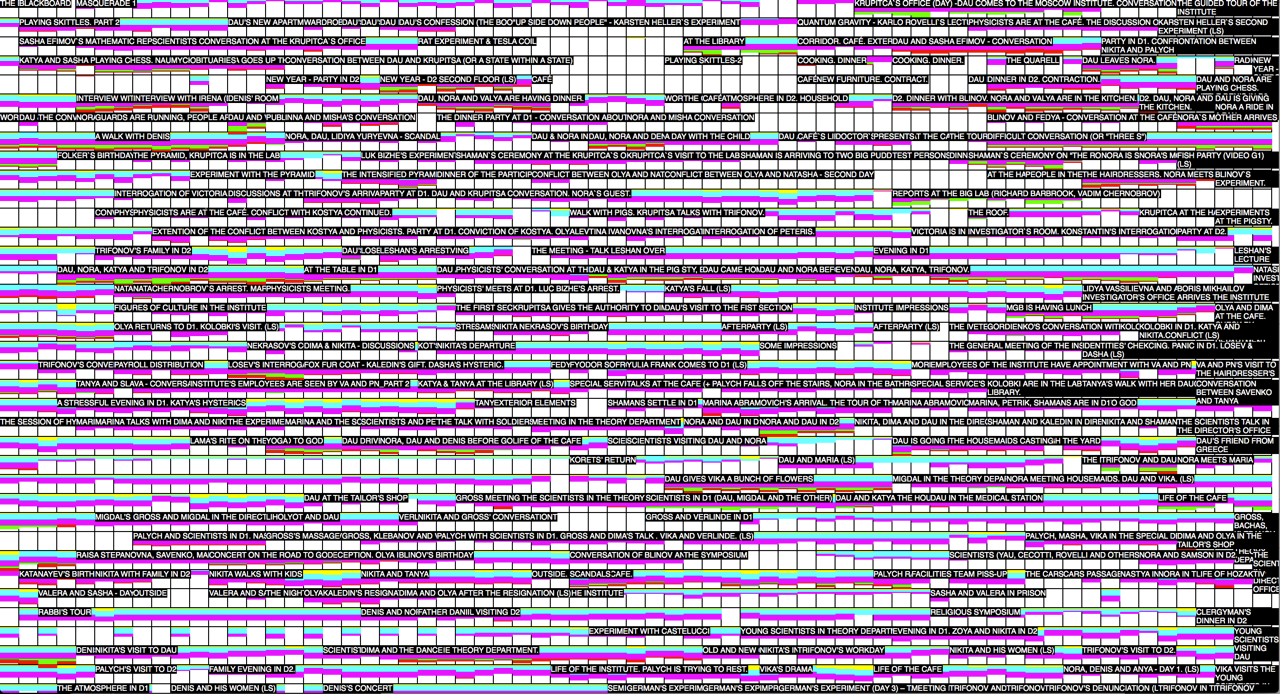I’ve suggested to the Dau people in London that they/I organize a pair of workshops in the Fall to expose various sorts of people (from archivists to IF/AI/UX enthusiasts) to the bulk of the footage they’ve collected and see what ideas can come from it—both for Dau in particular, and using it as a model for thinking broadly about the future of cinema.
I don’t know if any of you are interested, but if you want to come to London with me this Fall to make crazy prototypes for a crazy project (the text below is lovely—check it out) let me know! We want the first (of two?) workshop to be as early as September, and there are two dates we’re tossing around: 11-15 Sept, and 29Sept-4Oct. If you wanted to come, would either block of time work better than the other for you?

(interactive visualization of “subscenes” in DAU, chronologically, with annotation density by color)
Your correspondent,
R.M.O.
—
What is DAU
DAU is a large scale film and trans media project directed by Ilya Khrzhanovksy. The setting is 1938-1968 in the Soviet Union. Shot over several years in Russia and the Ukraine DAU is now post-producing in London.
The project generated 700 hours of rushes all shot on 35mm out of which 10 feature films, 9 TV series, a slate of science and arts documentaries and a trans media project will be made. DAU will be in post-production until spring 2015.
Project description
Shot in Russia and Ukraine between 2008 and 2011, DAU was first conceived as a full-length feature film based on the life of Lev Landau (1908 – 1968), a Soviet Nobel Prize winning physicist. Over time the project developed into a two year long staged reality experience located in Kharkov in the Ukraine on the largest set ever built in Europe (an area totalling 12,000 square meters), which became known as The Institute. The Institute was a dynamic, creative reconstruction of а Soviet access-restricted institute of 1938-1968. As part of this reality experience, all DAU participants lived and worked in The Institute for these two years.
The rules of the Institute were extremely rigorous. No modern devices, such as computers or mobile phones, were allowed and all participants and crew were required to wear historical clothes and hairdo’s at all times. This included underwear, stockings, glasses and even menstrual pads made from cloth. Visitors were subject to the same rules.
What started off as a single film production transformed into the most ambitious collective experiment. Around 400 participants from various social backgrounds were given the extraordinary opportunity to reinvent themselves in a different context and environment, within this staged reality experience at The Institute. These participants included scientists, barmaids, housekeepers, secret police, caretakers, journalists, criminals, cooks, hairdressers, tailors, shamans, a priest, a rabbi, craftsmen, etc.
The fully developed infrastructure of The Institute included workspaces (laboratories, offices), public spaces (restaurant, library, hairdresser, tailor) and residential premises. It had its own 24/7 local radio and a weekly newspaper; salaries were paid to the employees in authentic Soviet banknotes.
Participants interacted with each other, finding themselves in a challenging historical context and challenging situations. They fell in and out of love. They got married. They had children. They would be confronted with interrogations by the KGB and find themselves betraying close friends and colleagues. The inescapable desire for status and visibility led to participants sacrificing a relationship for a career within The Institute. Scientists would willingly carry out research for the construction of weapons of mass destruction while in their private lives the Institute participants would party ferociously.
Leading contemporary scientists, philosophers, artists, theologians and shamans were invited to take part in this extraordinary experiment and used The Institute as a unique place for interaction. All scientific research revolved around non-linear concepts of reality, time and space using all possible means, be they spiritual, philosophical, scientific or artistic to explore the limits of knowledge.
Among the participants of The Institute were Prof. David Gross (theoretical physicist, Nobel Prize in physics, 2004), Dr. James Fallon (Neuroscientist, extensive works on the brain of psychopathic murderers), Teodor Currentzis (conductor, three time winner of the Russian National Theatre Award Golden Mask), Prof. Shing-Tung Yau (Mathematician, Fields Medal 1982, Wolf Prize 2010), Prof. Carlo Rovelli (founder of loop quantum gravity theory), Prof. Nikita Nekrasov (leading specialist in string theory), artists such as Marina Abramovic and Carsten Höller, theatre, opera, and festival directors Peter Sellars, Anatoliy Vassiliev, Romeo Castellucci and Dmitri Tcherniakov, Rabbi Adin Steinsaltz, Peruvian Shipibo and Siberian Tuvian shamans as well as an orthodox priest. And many more.
Life in The Institute was filmed in documentary style, following the different participants in their development through time. Our feature films and TV series map the personal stories and dramas of our main characters as their narratives evolve and overlap. Each film or TV series tells someone’s story from their personal point of view.
The project is Russian speaking.
Production details
DAU is a co-production involving Phenomen Films (Russia), Phenomen Ukraine (UA), Essential Filmproduktion (Germany), Parisienne de Production (France), Plattform Produktion (Sweden). Attached partners are Ministry of Culture of the Russian Federation (Russia), Ministry of Culture and Tourism of Ukraine (UA), Arte France Cinema (France), WDR/Arte (Germany), Medienboard Berlin-Brandenburg (Germany), Mitteldeutsche Medienförderung (Germany), Eurimages (EU), The Swedish Film Institute (Sweden), Film i Väst (Sweden), AG Interfin B.V. (Netherlands), Hubert Bals Fund (Netherlands).